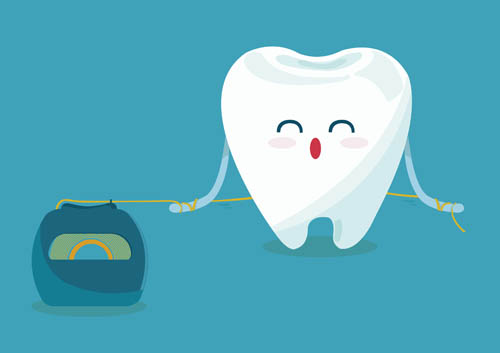August 17th, 2018

Of all the dental hygiene techniques you can use at home to promote clean teeth and good oral health, flossing is likely to be the one that troubles most people. It can be viewed as confusing and time-consuming, but when you learn how to floss your teeth correctly, you’ll find it’s easy to do on a daily basis.
Proper flossing techniques are vital to the health of your teeth and gums. These tips will help you with the correct flossing procedures. Likewise, Dr. Kozica and our team can also help you learn how to floss effectively and efficiently.
Steps to Flossing Your Teeth Properly
- Choosing Dental Floss. You can find dental floss in various flavors, as well as waxed or unwaxed. If the floss you use seems to get stuck between your teeth, switch to waxed to make it easier.
- Flossing “Helpers.” Beginner flossers who have trouble coordinating the floss and the movements of their hands can use a floss holder to help them get in and around teeth.
- Preparing the Floss. Cut an 18-inch piece of floss to use for flossing a few teeth. This allows you to make progress before you must stop and cut another piece of floss.
- How to Hold It. Wind the ends around your middle fingers. Hold the floss taut, pinching each side with your thumbs and index fingers. Leave a couple inches free in the middle.
- The Process of Flossing. Use your index fingers to guide the floss toward your gum line. Bring it down between the teeth with a zigzag motion. Hold the floss in a C-shape around the tooth, and move it up and down along the side.
- Where to Floss. Use a clean portion of the floss to clean around and in between each tooth. Don’t forget about the molars in the back of your mouth, too!
Flossing: A Vital Part of Oral Care
Periodontal disease begins at the gum line; this is where flossing comes in. Regular flossing helps you remove plaque from the gum line and between your teeth to avoid gum disease. In conjunction with daily brushing and twice-a-year visits to Kozica Dental, floss each day to maintain good oral hygiene and overall health. Gum disease can have an impact on your general health, but it doesn't have to. This easy-to-prevent condition can be avoided with regular visits to our Worcester office and daily flossing. Allow our team to partner with you in maintaining a bright, shiny smile and good oral health.
August 10th, 2018

A smile makeover is usually a combination of one or more cosmetic dental procedures. To achieve your desired result, Dr. Kozica may perform or suggest a variety of options. The entire process is designed specifically for your unique cosmetic needs, and Dr. Kozica will make sure all your concerns regarding your smile are addressed.
Here are some of the most common procedures in cosmetic dentistry and how they work:
- Tooth whitening – Whiter teeth are achieved through a bleaching process typically using hydrogen peroxide or carbamide peroxide. Yellower teeth usually respond well to this procedure, while brown-colored teeth stained by fluorosis or taking tetracycline do not respond as well to whitening. Tooth whitening is not for everyone; if you have sensitive teeth, gum disease, or poor enamel, Dr. Kozica may recommend against tooth-whitening services.
- Orthodontics – Braces are one of the tried-and-true ways of achieving a healthier smile. Braces are typically worn between 12 and 24 months to reposition the teeth in a straighter and safer alignment. Since your bite is also corrected during this process, it helps ensure you won't have any trouble down the line. There are several different types of braces available these days including: traditional metal braces, clear ceramic braces, lingual braces, and clear aligners.
- Veneers – Veneers are thin, tooth-colored material (porcelain or resin) designed to be placed on the front surface of teeth to improve their overall appearance. They can be used in cases where the color, shape, size, or length is not as desired. Veneers are usually used in cases where teeth are discolored, chipped, worn down, misaligned, irregular, or have gaps.
- Implants/bridges – Dental implants and bridges are used to replace missing or broken teeth. Nowadays, both implants and bridges are commonly performed procedures. Implants integrate directly with the jawbone, while bridges are placed over the adjacent teeth to the missing tooth. Implant technology has advanced a great deal in recent years and highly biocompatible ceramic materials are becoming more commonplace.
Getting your perfect smile will take time and patience, but the end result will be well worth it! Please schedule an appointment at our Worcester office about the cosmetic dental services we offer, and achieve the smile you've always wanted!
August 3rd, 2018

You might have a small chip in a tooth from an unfortunate encounter with peanut brittle, or even several chips from a touch football game that got a little out of hand. Perhaps you have a gap in your teeth that you’ve always wanted to address. Or it could be that you are not happy with the shape or color of your teeth, and are looking for a straighter, brighter smile. In all these cases, veneers may the perfect solution for you.
Veneers are one of the most dramatic ways to improve your smile:
- Realistic Appearance: A dental veneer is a thin shell of porcelain that is bonded to your tooth. Because they are semi-translucent, much like actual enamel, veneers look like natural teeth.
- Rapid Transformation: Normally, the application of veneers requires only a few visits. Your tooth will be shaped to accommodate the veneer for a smooth, flat appearance. A mold will be made to ensure an exact fit. On a subsequent visit, the new veneer will be bonded to the tooth permanently.
- Whiteness that Lasts: Veneers are stain-resistant, so if you are looking for a long-lasting bright smile, they are a good option. (If you are getting only a few veneers, it is a good idea to have your natural teeth whitened to the shade you desire before the veneer color is selected. Veneer color is permanent.)
There are also some aspects to consider before going ahead with the procedure:
- Be Sure About Your Decision: Veneers are a permanent choice. Some enamel might need to be removed for the veneer to fit and the surface of your tooth will be treated to allow the veneer to bond to it properly.
- Check Your Overall Dental Health: You should have a check-up before starting the process to make sure your teeth and gums are healthy enough for veneers. If you have severe orthodontic issues, grind your teeth, or have a habit of clenching your jaw, your veneers will be put under pressure they were not designed to take. We can let you know if you are a good candidate for this procedure.
- Expense: Veneers are more expensive than some other options, such as whitening and bonding, but can offer more benefits. Veneers will cover staining that whitening cannot eliminate. Their translucent quality makes them look more realistic than bonding, and they are also far more stain resistant. The cost of a crown might be comparable, and a crown is recommended if there is significant damage to the underlying tooth. If you are looking for cosmetic improvement only, veneers leave more of the tooth intact.
- Longevity: Veneers do not last forever, and will need to be replaced eventually. However, they can have a life expectancy of ten to 15 years, and we can give you tips to keep your veneers looking and lasting their best.
If you decide veneers are right for you, give our Worcester office a call. We will be happy to discuss the procedure with you and help you discover the best possible path to your best possible smile.
July 27th, 2018
Nitrous Oxide Dental Treatment at Kozica Dental

Nitrous oxide is a gaseous sedative that’s inhaled through a small mask placed over the nose. Often referred to as laughing gas — because of the euphoric effects it produces — nitrous is used in our Worcester office for its anesthetic/analgesic properties.
It will make it so you don’t feel the pain of dental treatment or have an experience that some patients may find traumatic.
Nitrous oxide’s use in the dental field dates back to about the mid-1800s, but when it was introduced, practitioners didn't understand the need to add oxygen. These days all nitrous oxide is administered with at least 30% oxygen for safety (so it forms the compound N2O-O2).
If you need any form of dental treatment, Dr. Kozica may find it necessary to administer nitrous oxide. Some of the effects you may experience while you’re sedated include:
- Lightheadedness, tingling in the arms and legs, followed by a warm or comforting sensation
- A euphoric feeling or feeling like you are floating
- Inability to keep your eyes open, so it seems as if you’re asleep
If at any time you feel uncomfortable, irritated, or sick, let Dr. Kozica know, so the percentage of nitrous oxide being used can be adjusted. The effects dissipate quickly once you return to breathing regular air.
It’s best to be informed about all aspects of your dental treatment before you arrive. There are alternatives to nitrous oxide, so if you’re at all concerned, please don’t hesitate to ask questions about other options for sedation.
Analgesic (numbing) injections can often be used locally at the surgical site. We’ll find what works best for your particular case.




